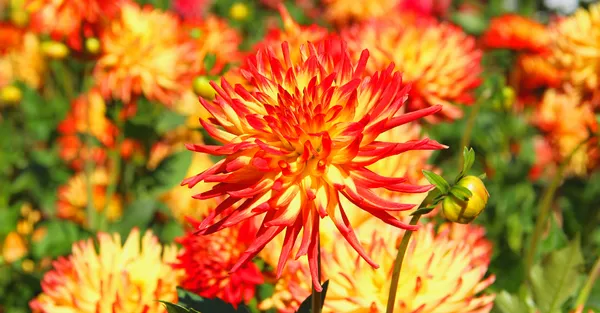Star Jasmine (Trachelospermum jasminoides), also known as Confederate Jasmine, is a popular evergreen vine cherished for its delightful fragrance and beautiful white blooms. However, as a gardener, it can be disheartening when your star jasmine fails to produce flowers. Several factors could contribute to this issue, ranging from environmental conditions to improper care. In this article, we will delve into the potential reasons behind the lack of flowering in star jasmine to help you troubleshoot the problem and encourage your vine to bloom once again.
Star Jasmine is a woody, twining vine native to East Asia and is widely cultivated for its ornamental value. Its glossy, dark green leaves and star-shaped, sweet-scented flowers make it a popular choice for gardens, trellises, and fences. Star Jasmine is generally a low-maintenance plant, but when it fails to produce flowers, it may be an indication of underlying issues.
1. Lack of Sufficient Sunlight
Star Jasmine thrives in bright, indirect sunlight. Lack of adequate sunlight is one of the primary reasons why this vine may not flower as expected. Insufficient light can limit the plant’s ability to produce the energy required for flower bud development and may result in sparse or no blooms.
Solution
Ensure that your star jasmine receives at least 4-6 hours of sunlight per day. If it is grown indoors, place it near a south-facing window where it can receive bright, filtered light. Outdoor plants should be situated in a location with partial to full sun exposure.
2. Improper Pruning
Pruning plays a crucial role in shaping and maintaining the health of star jasmine. However, incorrect pruning practices can lead to reduced flowering. If you prune the vine at the wrong time, such as during the flowering season or in late summer, you may inadvertently remove the flower buds for the following year.
Solution
Prune star jasmine immediately after flowering or during late winter or early spring before new growth begins. This timing allows the plant to develop new buds and ensures that you do not remove the buds formed for the upcoming blooming season.
3. Nutrient Deficiencies
Phosphorus is essential for flower production in plants. A deficiency in phosphorus can hinder the development of buds and flowers, leading to a lack of blooms in star jasmine.
Solution
Choose a balanced fertilizer or one specifically formulated for flowering plants. Look for a fertilizer with a higher middle number in the N-P-K ratio, indicating a higher phosphorus content. Apply the fertilizer according to the manufacturer’s instructions to provide the necessary nutrients for flowering.
4. Improper Watering Practices
Both overwatering and underwatering can negatively impact the blooming of star jasmine. Overwatering can lead to root rot and other fungal diseases that affect the plant’s health, while underwatering can cause stress and limit the plant’s ability to produce flowers.
Solution
Water star jasmine consistently but avoid waterlogged soil. Allow the top inch of the soil to dry out before watering again. Ensure proper drainage to prevent water from stagnating around the roots. Using a moisture meter can help you determine the right watering frequency.
5. Unsuitable Soil Conditions
Star Jasmine prefers well-draining soil to prevent waterlogged conditions that can lead to root problems. Compacted or poorly drained soil can suffocate the roots, causing the plant to struggle and inhibit flowering.
Solution
Choose a loose, well-draining potting mix or amend garden soil with organic matter to improve drainage. Avoid heavy clay soils that tend to hold water for extended periods.
6. Environmental Stressors
Star Jasmine is sensitive to extreme temperatures, especially frost and freezing conditions. Cold snaps can damage the plant, affecting its ability to flower in the following season.
Solution
If you live in a region with harsh winters, consider growing star jasmine in containers so you can bring it indoors during cold spells. If growing outdoors, cover the plant with frost cloth or straw during freezing temperatures to protect it from damage.
7. Pests and Diseases
Pests like aphids, spider mites, and whiteflies can attack star jasmine, causing stress to the plant. Prolonged infestations can weaken the plant and reduce flowering.
Solution
Inspect your star jasmine regularly for signs of pests and treat infestations promptly. Use natural predators or appropriate insecticides to control pest populations and minimize their impact on the plant.
8. Age of the Plant
Young star jasmine plants may take some time to establish their root systems and reach maturity. Flowering may be limited or sporadic in the early stages of growth.
Solution
Be patient with young star jasmine plants and provide them with optimal care to encourage healthy growth and development. As the plant matures, it will have a better chance of producing abundant blooms.
9. Lack of Proper Support
Star Jasmine is a climbing vine and requires adequate support to grow and flourish. Without proper support, the vine may not reach its full potential and might not produce as many flowers.
Solution
Install a sturdy trellis, fence, or other support structure for your star jasmine to climb on. This will encourage upward growth and enable the plant to produce more flowers.
Conclusion
Growing star jasmine can be a rewarding experience, but when the plant fails to produce flowers, it can be frustrating. By understanding the potential reasons behind the lack of flowering and implementing the appropriate solutions, you can encourage your star jasmine to bloom abundantly once again. Ensure the plant receives sufficient sunlight, maintain proper pruning practices, provide adequate nutrients and water, and protect it from environmental stressors. With a little care and attention, your star jasmine will be adorned with its signature white, star-shaped blooms, filling the air with its sweet fragrance and adding beauty to your garden or home.


